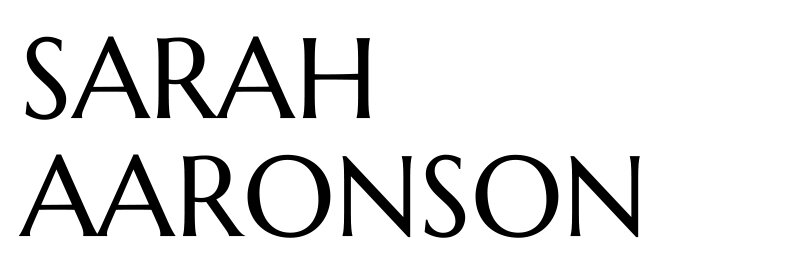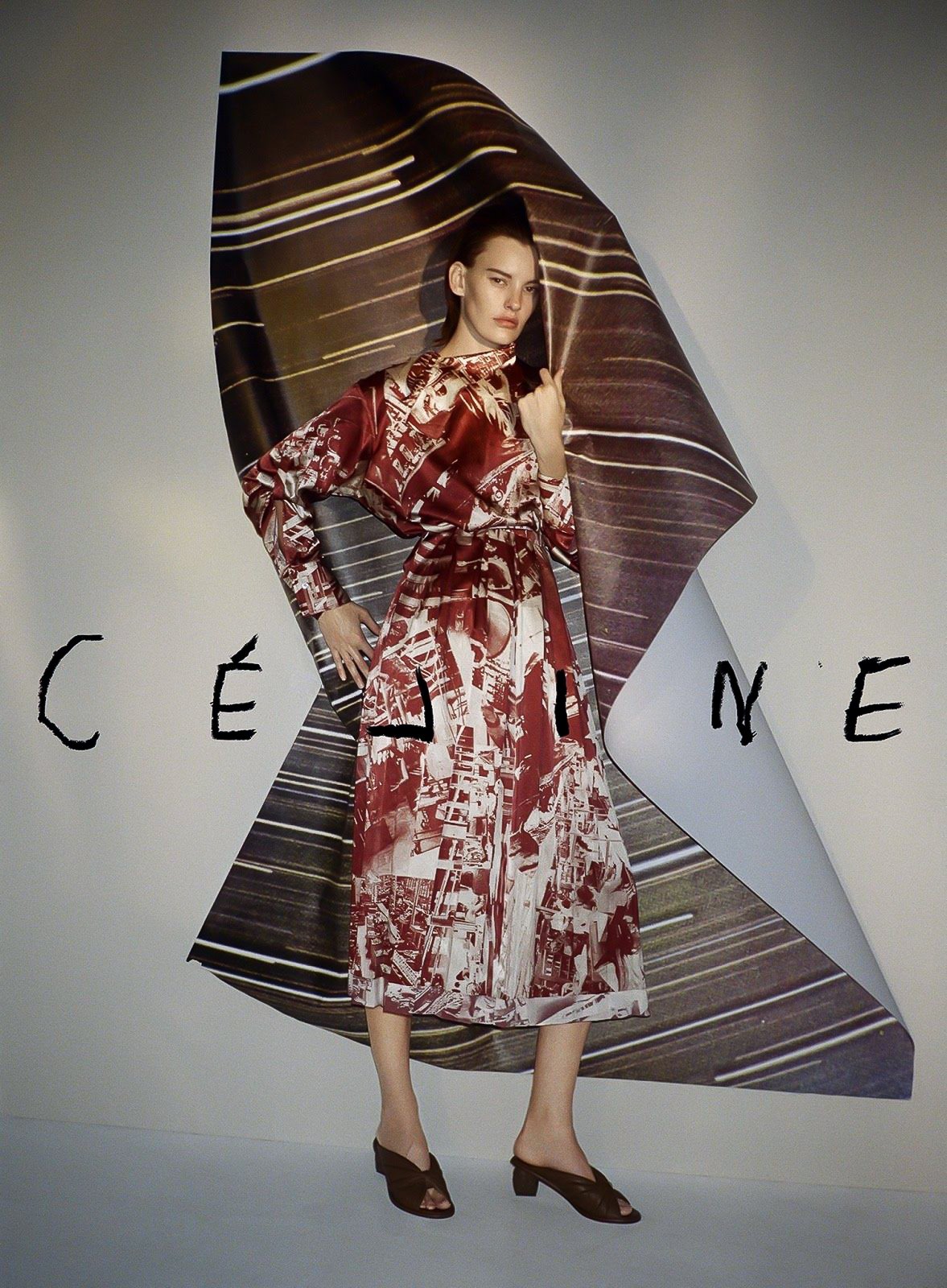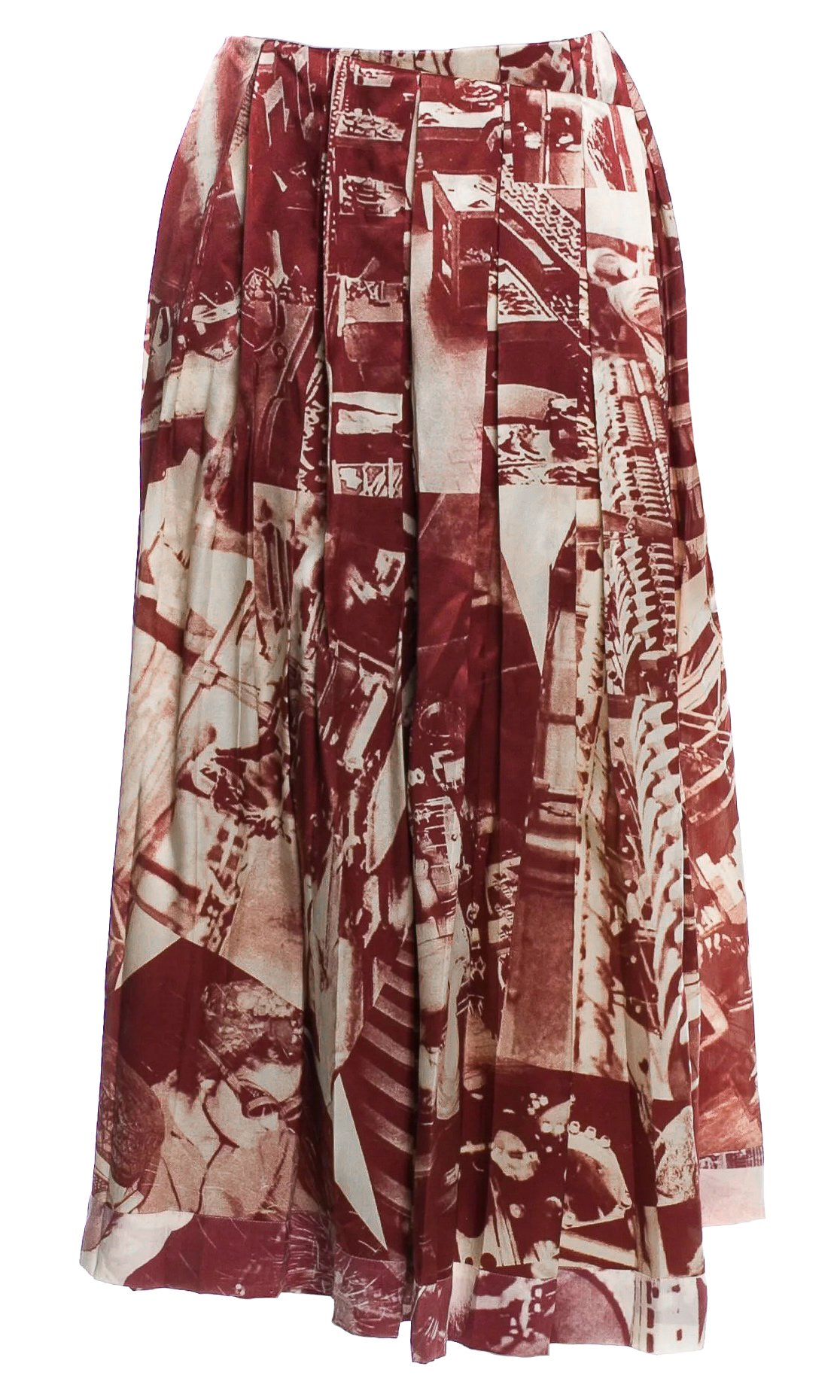SHAPE SHIFTERS
Soviet propaganda illustration on the cover of the journal Daesh’! N° 2 depicting the Emulation of Socialism • May 1929 • Aleksandr Deyneka • Museum of Modern Art, New York City
How Phoebe Philo juxtaposed her Spring 2018 Trojan Women print (see yesterday’s post) with additional textiles featuring images of women working in factories printed on proletariat shapes, reminiscent of Russian Constructivist Art created during the early 20th Century. Perhaps Philo’s pairing of images featuring women battling to survive war, with images of women working in factories was a subversive message suggesting that not only are women often innocent victims of war, but that they are the backbones of society during turmoil as well... With this in mind, Philo’s collection reaffirms the Constructivist theory that “Fashion can be understood as a physical means through which to create and reflect cultural meaning. The consumption of fashion as a material good represents values of the consumer and is central to the construction of identity and selfhood. Fashion can be seen as a text in which one can observe the values associated with social identities through their visual expression; concurrently, fashion can be a vehicle for socialization and social control or, alternatively, for liberation from cultural constraints...”
In a society faced with dynamic vicissitudes throughout most of the 20th century, Constructivism endeavored in the early 1900s to modify and radically restructure the value of material goods through the transfiguration of aesthetics, as well as through attempts at mass production. Constructivists understood that to fully exemplify the Socialist Revolution, Constructivist aesthetics and values must extend to the sphere of fashion, which was characterized by the functionality of its shapes and the simplicity of its geometric patterns. Of paramount importance to Constructivist designers was the reconstruction of gender relations and roles. As female artists and designers in male-dominated structures, their radical involvement in socialist creative fields situate their desire to alter hegemonic norms. A woman has to cease to be a thing, a commodity, the object of a picture, and with women as creators, such transformation occurred... • Constructivism: Fashioning Socialist Modernity by Joseph Weinger
Red Spinner • 1930 • Andrey Golubev • The Burilin Ivanovo Museum of Local History, Ivanovo
A model wearing a factory print ensemble from the Spring / Summer 2018 Collection • Phoebe Philo for Céline
Original Soviet poster proclaiming the following message : “Emancipated Woman, Build Socialism!” • 1926 • Adolf Strakhov • The David King Collection at Tate, London • Image courtesy of La Mode en Union Soviétique : 1917-1945 by Tatiana Strijénova
Amanda Murphy modeling a factory print ensemble from the Spring / Summer 2018 Collection • Phoebe Philo for Céline • Stylist UK Magazine • Quentin Jones
Forge • Printed cotton cloth featuring a proletariat factory motif • 1931 • S. Bountsis • Image courtesy of La Mode en Union Soviétique : 1917-1945 by Tatiana Strijénova
A model wearing a factory print ensemble from the Spring / Summer 2018 Collection • Phoebe Philo for Céline • Numéro Russia • Kin Coedel
Diana Z Wang modeling a factory print tunic from the Spring / Summer 2018 Collection • Phoebe Philo for Céline • Image courtesy of Z Hours
Factory motif printed cotton celebrating March 8th, International Women’s Day • Circa Late 1920’s - Early 1930’s • D. Preobrazhenskaya • Russian Museum, Leningrad • Image courtesy of Revolutionary Textile Design : Russia in the 1920’s and 1930’s by I. Yasinskaya
Osip Brik featured in an unpublished collage made for the magazine Lef • 1924 • Aleksandr Rodchenko • The Pushkin State Museum of Fine Arts, Moscow • Image courtesy of Rodchenko & Popova : Defining Constructivism by Margarita Tupitsyn in association with the 2009 exhibition at Tate Modern, London
Detail of a silk tunic featuring a collaged factory print depicting female workers on the job • Spring / Summer 2018 Collection • Phoebe Philo for Céline
A worker in one of Moscow's factories, where thousands of women have replaced men on machines of all kinds • Circa 1941 • Moscow, USSR • Image courtesy of the Library of Congress
A model wearing a factory print ensemble from the Spring / Summer 2018 Collection • Phoebe Philo for Céline
Cover of the catalogue L’Art Decoratif U.R.S.S. : Moscou - Paris • 1925 • Aleksandr Rodchenko • Collection of David King, London • Image courtesy of Rodchenko & Popova : Defining Constructivism by Margarita Tupitsyn in association with the 2009 exhibition at Tate Modern, London
Silk skirt featuring a collaged factory print depicting female workers on the job • Spring / Summer 2018 Collection • Phoebe Philo for Céline
Original Soviet propaganda poster depicting proletarian women, female delegates and shock-workers • 1931 • Natalia Pinus • Private Collection • Image courtesy of The Soviet Photograph, 1924 - 1937 by Margarita Tupitsyn
Silk tunic featuring a collaged factory print depicting female workers on the job • Spring / Summer 2018 Collection • Phoebe Philo for Céline
Soviet woman captured working in a factory • Circa 1920’s • Emmanuil Yevzerikhin • Multimedia Art Museum, Moscow
Printed cotton fabric entitled Factory • 1927 • S. Burylin • Russian Museum, Leningrad • Image courtesy of Revolutionary Textile Design : Russia in the 1920’s and 1930’s by I. Yasinskaya
Cog-wheels • Silver gelatin photograph of AMO Automobile Factory car parts for the journal Daesh’! N° 14 • 1929 • Aleksandr Rodchenko
Volta, a thin cotton fabric printed with a factory motif • 1929 • E. Nikitina • Russian Museum, Leningrad • Image courtesy of Revolutionary Textile Design : Russia in the 1920’s and 1930’s by I. Yasinskaya
A model wearing a factory print tunic from the Spring / Summer 2018 Collection • Phoebe Philo for Céline
Cinematic photograph of a Soviet factory from USSR in Construction, an English-language publication of the Soviet Union • Circa 1930’s • Image courtesy of Widener Library, Harvard University, Cambridge
Cog-wheels • Silver gelatin photograph of AMO Automobile Factory car parts for the journal Daesh’! N° 14 • 1929 • Aleksandr Rodchenko
Detail of a silk tunic featuring a collaged factory print depicting female workers on the job • Spring / Summer 2018 Collection • Phoebe Philo for Céline
Balconies • 1925 • Aleksandr Rodchenko
Silk blouse featuring a collaged factory print depicting female workers on the job • Spring / Summer 2018 Collection • Phoebe Philo for Céline
Postcard for the All-Union Olympiad Spartakiada • 1928 • Moscow • Gustav Klutsis • Image courtesy of Letterform Archive
Playbill for the show Through Red and White Spectacles • 1923 • Varvara Stepanova • Rodchenko Stepanova Archive, Moscow • Image courtesy of Russian Constructivist Posters by Elena Barkhatova
Female Torso • Circa 1928 - 1929 • Kazimir Malevich • Image courtesy of Malevich by Achim Borchardt-Hume in association with Tate Modern, London
Agnes Nabuurs modeling an ensemble likened to Russian Constructivism from the Spring / Summer 2018 Collection • Phoebe Philo for Céline • January 19, 2018 • Harper's Bazaar Spain • Luis Álvarez
Sportsmen • 1930 - 1931 • Kazimir Malevich • Image courtesy of Malevich by Achim Borchardt-Hume in association with Tate Modern, London
Atelier de Tissage • 1934 • Alexander Samokhvalov • Image courtesy of La Mode en Union Soviétique : 1917-1945 by Tatiana Strijénova
Girl with Comb in Hair • Circa 1932 - 1933 • Kazimir Malevich • State Tretkyakov Gallery, Moscow • Image courtesy of Malevich by Serge Fauchereau
Cover of the magazine Novyi Lef N° 11 • 1928 • Aleksandr Rodchenko • Museum of Modern Art, New York City
Achok Majak modeling an ensemble likened to Russian Constructivism from the Spring / Summer 2018 Collection • Phoebe Philo for Céline • 10 Magazine
Sketch of a dress • 1923 • Kazimir Malevich • Image courtesy of La Mode en Union Soviétique : 1917-1945 by Tatiana Strijénova
Cover of the magazine Novyi Lef N° 8 • 1928 • Aleksandr Rodchenko • Museum of Modern Art, New York City
Joan Smalls modeling an ensemble likened to Russian Constructivism from the Spring / Summer 2018 Collection • Phoebe Philo for Céline • Self Service Magazine N° 48 • Marton Perlaki
International Working Women’s Day Poster • 1930 • Valentina Kulagina • Image courtesy of La Mode en Union Soviétique : 1917-1945 by Tatiana Strijénova
Aweng modeling an ensemble likened to Russian Constructivism from the Spring / Summer 2018 Collection • Phoebe Philo for Céline • Indie Magazine • Antonio Mingot
Cover of the magazine Novyi Lef N° 6 • 1928 • Aleksandr Rodchenko • Museum of Modern Art, New York City
AMO - The First State Automotive Factory • Collage in the journal Daesh’! N° 14 • 1929 • Aleksandr Rodchenko • Helix Art Center, San Diego • Image courtesy of The Soviet Photograph, 1924 - 1937 by Margarita Tupitsyn
Design for The Society for the Struggle Against Illiteracy • 1924 • Liubov Popova • Tsaritsyno Museum of History, Moscow • Image courtesy of Rodchenko & Popova : Defining Constructivism by Margarita Tupitsyn in association with the 2009 exhibition at Tate Modern, London
Varvara Stepanova (wearing a headscarf with a pattern designed by Liubov Popova) on the cover of Technology and Life N° 5 • 1925 • Cover designed by Alexei Gan & Aleksandr Rodchenko • Rodchenko Stepanova Archive, Moscow • Image courtesy of Gan’s Constructivism : Aesthetic Theory for an Embedded Modernism by Kristin Romberg
Malgosia Bela modeling an ensemble likened to Russian Constructivism from the Spring / Summer 2018 Collection • Phoebe Philo for Céline • April | May 2018 • Interview Magazine • Chris Colls
International Women’s Day Soviet Propaganda Poster • Early 20th Century
Dasha Khlystun modeling an ensemble likened to Russian Constructivism from the Spring / Summer 2018 Collection • Phoebe Philo for Céline • Grazia Magazine
Plate from 6 Prints • 1917 • Liubov Popova • Image courtesy of Popova by Dmitri V. Sarabianov and Natalia L. Adaskina
Design for unisex sports apparel • 1928 • Varvara Stepanova
Cover for Sergei Tret'iakov’s Rechevik. Stikhi • 1929 • Aleksandr Rodchenko • Museum of Modern Art, New York City
Design for unisex sports apparel • 1928 • Varvara Stepanova
Amber Witcomb modeling an ensemble likened to Russian Constructivism from the Spring / Summer 2018 Collection • Phoebe Philo for Céline • 10 Magazine Issue 60 • Mattias Björklund
Cover design for the magazine Questions of Stenography N° 3 • 1924 • Liubov Popova • Tsaritsyno Museum of History, Moscow • Image courtesy of Rodchenko & Popova : Defining Constructivism by Margarita Tupitsyn in association with the 2009 exhibition at Tate Modern, London
Shujing Zhou modeling an ensemble likened to Russian Constructivism from the Spring / Summer 2018 Collection • Phoebe Philo for Céline • May 2018 • Vogue China • Tim Wong
Original Soviet poster proclaiming the following message : “Female shock-workers of the factories and collective farms, join the ranks of the Communist Party.” • Circa 1932 • Valentina Kulagina
Original Soviet poster proclaiming the following message : “Female shock-workers, strengthen the shock brigades, master technology, and increase the ranks of proletarian specialists.” • 1931 • Valentina Kulagina • Museum of Modern Art, New York City
Rostselmash Factory Worker • Circa 1937 - 1938 • Mikhail Prekhner
Aleksandr Rodchenko in the studio dressed in an industrial jumpsuit against a background of spatial constructions • Circa 1924 • Mikhail Kaufman • Image courtesy of the collection of the Moscow House of Photography via the Multimedia Art Museum, Moscow
Design for Working Clothes (Prozodezhda) • 1922 • Aleksandr Rodchenko • Private Collection • Image courtesy of Rodchenko & Popova : Defining Constructivism by Margarita Tupitsyn in association with the 2009 exhibition at Tate Modern, London





































































